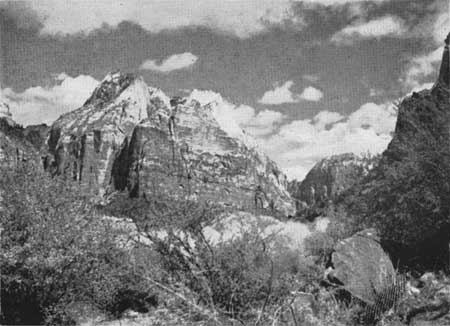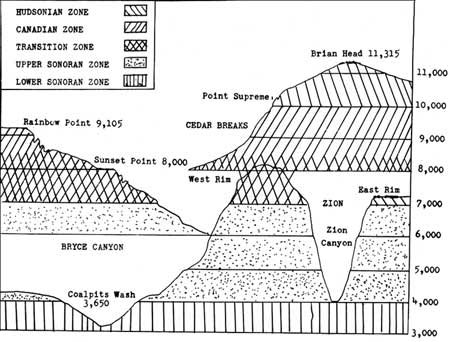|
ZION, BRYCE CANYON, CEDAR BREAKS
Birds of Zion, Bryce and Cedar Breaks |

|
March, 1947
Zion-Bryce Museum Bulletin
Number 5
Zion-Bryce Museum Bulletin
Number 5
THE BIRDS OF ZION, BRYCE, AND CEDAR BREAKS
DISTRIBUTION AND HABITAT
There are many factors that determine where a certain species is likely to be found. Availability of water, food and adequate protective cover will enable a bird to utilize one locality while somewhat similar areas nearby are not used because one or more of these vital factors may be lacking. For example, the Sharp-shinned Hawk is certainly not a resident of the upper desert zone found on the slopes in Zion Canyon. Yet the bird has been known to nest in this zone simply because in one small protected area water, slope and temperature have combined to allow a forest growth not normally found at such a low elevation, and, as this type of forest is the usual habitat of the hawk in the higher elevations, it was utilized as a nesting site. As a usual thing, however, birds tend to remain more or less within certain climatic limits, and the plants found within that climatic zone constitute the normal habitat of the species. Altitude is important, but not vital, the climatic zone being the controlling factor. Thus a nesting bird of the transition zone may be found in one region at 4,000 feet elevation, while in another region he may have to go up to 8,000 feet to reach the same climatic belt. And, just as each bird requires a definite climatic zone in which he normally nests, so is he usually found around certain habitats within that zone. One would never look for a woodpecker around a sand flat or a sandpiper on a rock slope, even though the climatic zone might be the one in which either bird might be found. Thus, knowledge of habitat requirements is of great importance, as such information definitely limits the scope of study when identifications are being made.

The heavily vegetated floor of Zion Canyon attracts many species of
birds during the summer. Grater Photo.
In the region covered by this publication there is a vast range of habitat types and climatic zones. The Markagunt Plateau, upon which Zion and Cedar Breaks are located, ranges in altitude from around 3,000 feet at its southern end to over 11,000 feet near Cedar Breaks to the northward. Northeast of Zion, the Paunsaugunt Plateau, with Bryce Canyon nestled in the cliffs on the eastern face, reaches a maximum elevation of 9,105 feet. The topographic features of both plateaus are somewhat similar, in that both are characterized by terraces and table lands, deeply incised by numerous canyons. The climate and vegetation in both areas are very much alike.
Starting at the lowest elevations and working upward, one travels through a constantly changing world of plant cover. Around the 3,000-foot level is found the low desert zone, or Lower Sonoran Zone. This zone extends upward to approximately the 4,000-foot level and includes the extreme lowlands of Zion. The plant cover of this zone is made up of desert chaparral, in which creosote bush and black brush are the dominant species. Above this dry, treeless region comes the high desert belt, or Upper Sonoran Zone. This zone extends to around 7,000 feet in elevation, and includes a large portion of Zion and the extreme lowlands of Bryce Canyon. The plant life within this climatic belt varies considerably. In the dry situations, the plant cover ranges from various species of low brush to the "pygmy forest" of the pinon pine and Utah juniper. In the canyon depths the stream courses afford an abundance of moisture, and here a luxurious growth of broad-leaf trees and brush is found. In the protected tributary canyons are many areas in which forest types of higher climatic zones grow in profusion. From the high desert belt the Transition Zone reaches upward to approximately 8,500 feet, and includes the high-lands of Zion and the major portion of Bryce Canyon. This zone is characterized by the ponderosa pine forest. From 8,500 feet to 10,000 feet is found the Canadian Zone, with its fine forests of aspen, white fir and spruce. The highlands of Bryce Canyon and the major portion of Cedar Breaks are found in this zone. The Hudsonian Zone is restricted to the region around Cedar Breaks, and reaches its maximum elevation of 11,315 feet on Brian Head. It is characterized by forests of spruce and alpine fir, interspersed with open alpine meadows.
While the life zones of this region are more or less definitely defined, it should he pointed out that such zones break down very quickly locally. For example, Zion Canyon contains a wide variety of plants that are supposed to be characteristic of certain life zones. In the canyon can be found typical Upper Sonoran, Transition and Canadian Zone plants growing within a few hundred feet of each other. Cactus and yucca are not infrequently found growing only a few feet from white fir trees. Such an unusual relationship can be readily explained. Dry, hot, exposed slopes, typically desert in character, are often only a matter of yards from a moist, cool, protected area that is typical of what one would expect to find high on the plateau. In these restricted areas, plants will thrive that would normally be found in such habitats. Because of this diversification of habitat throughout the plateau country, plant and animal "communities" are recognized locally, while the conception of life zones applies regionally. If this principal is recognized, needless confusion will be eliminated and the records obtained simplified. Certainly a Canadian Zone bird found nesting at 4,500 feet elevation in a grove of trees that are typical of the high plateau forest cannot be classed as an Upper Sonoran Zone resident. The bird is still Canadian Zone in its requirements, and would not have remained if the moist belt trees had not been there. Thus the importance of an understanding of local conditions becomes apparent if one is to obtain an accurate conception of the bird life of this region.

Life zone chart
(click on image for an enlargement in a new window)
It is immediately apparent that the bird life of a region containing such a vast altitudinal range is certain to present a wide variety of species. Thus far, over 170 varieties have been recorded from Zion, Bryce Canyon and Cedar Breaks, with several other species having been observed in nearby areas.